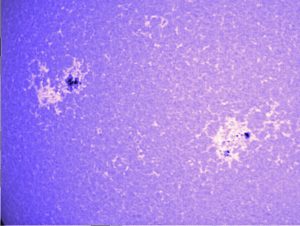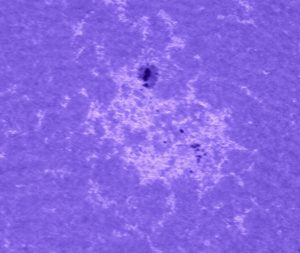By Austin Grant

Lunt Calcium K Filter Review: I remember from an early age being told not to look directly at the sun, and I’m also quite sure that my first pair of binoculars had a sticker on them instructing me to absolutely not point them at the sun. So, you can imagine my surprise the first time I heard about a solar observing session.
I was blown away with the idea of even looking at the sun, and then again when I actually got to see it. Time has passed, and solar observing has quickly become my favorite type of observing. I’ve even purchased a couple of white-light filters and a Hydrogen-alpha telescope. The last piece of my puzzle was to snag a Lunt Calcium K module.
My first encounter with a Lunt Calcium K filter was during one of Stephen Ramsden’s solar outreach events with his Charlie Bates Solar Astronomy Project. We’d been observing a fairly-uneventful Sun that day, with none of the typical “wow” features.

The Hydrogen-alpha and white-light views were less than stunning. That changed when I switched to the Calcium K setup, through which, to me, it looked like a white-light filter on steroids … in HD! The details were unbelievable, and I knew I needed the opportunity to experience this more often.
According to Lunt Solar Systems, “Lunt Calcium K (Ca-K) telescopes and filters are used to study the wavelength of 393.4 nm. This emission line is one of two that are produced by Calcium just at the edge of the visible spectrum, in a layer that is slightly lower and cooler than the layer viewed in Hydrogen-alpha. The emission line displays areas of super granulation cells that are brightest and strongest in areas of high magnetic fields, such as sunspot activity and active regions.”
The isolation of this wavelength really shows a vastly different view from ones obtained by other filters. Prominent features visible with these filters include granulation, supergranulation, umbra and penumbra of the sunspots, and faculae. My favorite view is of the large networks of faculae, which form between the granulation cells and give the sun a cracked appearance. Besides all the cool stuff you can see, the most interesting thing is that a dull day through one type of filter could produce amazing views using another. That’s probably one of the best reasons to add a Calcium K filter to the arsenal.

One of the best ways to get into Calcium K viewing, both in terms of quality and cost, is a Lunt Calcium K Filter These are in a format that has a 2.0-inch slip-fit nosepiece that goes into your existing focuser, and after a diagonal it terminates in a 1.25-inch receiver. They are designed to be used with refractors up to 100-mm aperture with no need for an energy rejection filter.
If you want to try imaging, you can choose the correct-sized internal blocking filter based on your focal length. The options range from 6 mm to 34 mm. I used this module with an Explore Scientific 80-mm (ED80CF) telescope, so the B1600 blocking filter was perfect.
Before I discuss imaging, I’d like to share my experiences with using this Calcium K module visually. There are some obstacles to viewing versus imaging in Calcium K. The wavelength of the target Calcium K line is slightly shorter than what we call the edge of the visible spectrum. Although it’s dipping into the UV wavelengths, most people can make out the violet color.
Making out contrast, however, is tougher depending on the age of the observer. As we age, our corneas become yellowed, and that causes us to lose contrast at this end of the visible spectrum. In short, the older you are, the more likely it is that you’ll want to supplement your

usage of this Lunt Calcium K Filter with imaging. I tried it out with my astronomy students, and they were all able to see plenty of detail. We did use a nice light shield and shroud to boost contrast.
Imaging with the Lunt Solar Systems Calcium K filter was a breeze – same basic setup as for white-light or Hydrogen-alpha imaging,
just some tweaking of exposure settings. I used a QHY5L-II camera to capture the data, and a TeleVue PowerMate to get more resolution.
The full-disk images were pleasing, but I was most impressed with the more detailed images with the PowerMate. Seeing wasn’t excellent on the occasions I tried to image for this article, but because of my relatively short focal length, I was able to still get some great shots. It was also nice to just leave the camera running and watch the screen in live view mode. I was able to brighten it and get more contrast than I could visually through the eyepiece.

Bottom Line: Imaging with this system was very pleasing, and the details held up really well even with a strong Barlow.
Hydrogen-alpha telescopes and filters are mind-blowing. If you don’t have a Lunt 60-mm Pressure-tuned Hydrogen-alpha telescope, you should remedy that first. If you do, and you are looking to expand your options for solar viewing and imaging, the Lunt Solar
Systems Calcium K module is an excellent choice.
It’s a remarkably versatile piece of gear, and it will likely work with one of your existing telescopes. It’s an amazing accessory that will show you the Sun like you’ve never seen it. Depending on the solar activity that day, it’s often my favorite way to look at the Sun.

Austin Grant, a high-school Chemistry and Biology teacher, is a self-described perpetual hobbyist, experienced in such areas as building computers and repairing arcade equipment. Austin stumbled into astronomy several years ago and it soon became his primary interest. Being a child of the digital age, it didn’t take long for him to find digital astro-imaging and he sold his last pinball machine to fund his current imaging rig. Austin shares his passion for stargazing with his students.
And to make it easier for you to get the most extensive telescope and amateur astronomy related news, articles and reviews that are only available in the magazine pages of Astronomy Technology Today, we are offering a 1 year subscription for only $6! Or, for an even better deal, we are offering 2 years for only $9. Click here to get these deals which only will be available for a very limited time. You can also check out a free sample issue here.



